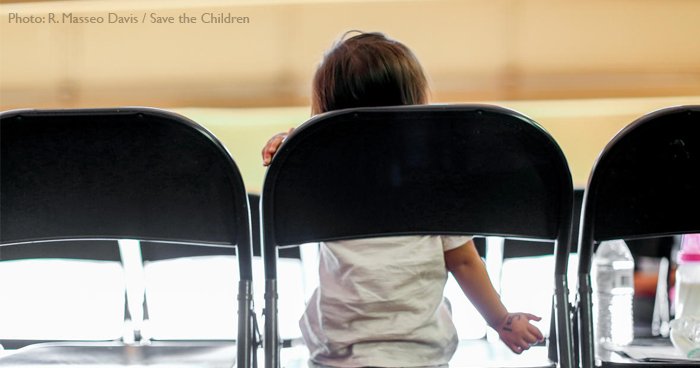
A 2-year-old arrives at the respite center in New Mexico.
For 3 weeks in July, I joined Save the Children programs at the U.S. southern border in New Mexico. While there, I gained many—sometimes hard to grasp—insights from serving families and children seeking asylum within the United States. I saw the importance of shoelaces, the dignity of a shower and the power of laughter. I also saw how the decisions made in Washington dramatically affect someone’s life down at the border.
The Situation at the Border
Many families have been away from their home for weeks, on a hard, long road, sometimes without food or water. Some have been convinced to seek help from coyotes, putting their faith and savings in strangers to help them cross over. Others have been separated from their spouse or other family members at the border, not knowing where they are headed or when they’ll reconnect. Almost every child and family comes to us after their time in a holding facility run by U.S. Customs and Border Patrol (U.S. CBP).
Whatever bags they had started their journey with are long gone, and things like shoelaces and belts are taken by Border Patrol. Little kids have trouble running around to play because their shoes come off and men are constantly pulling up their pants that are too big.
After collecting a bag of donated goods and finding their cots for the night, families are welcome to shower, rest and prepare for the rest of their journey.
Creating a Space for Children
In New Mexico, Save the Children is proud to partner with the two city-run hospitality shelters and the faith-based community’s hospitality centers. These shelters serve as much needed rest centers for families on the tail end of their journey to the U.S. The shelters offer resources (clothing, food, showers, diapers, toys, shoelaces, beds, etc.) to the families and help them connect with their sponsor to make travel arrangements.
Save the Children has created child friendly spaces within these shelters, a place where children can come play, moms and dads can care for very young children or nurse infants and everyone can rest. We organize games, color, dance and play soccer almost every day. The sound of kids laughing brings much needed relief to the parents. For many, laying down at the shelters after a shower is one of the first times they feel they can breathe and find a moment of stillness. These shelters provide one of the first positive, loving interactions in the U.S.
Within my first week working in our community play space, I made the U.S. map a permanent feature on the wall. Countless times, I was sitting down to color with kids while parents would come over and ask if I had heard of Sur de Carolina (South Carolina) and if I could point it out on the map. Soon there was a line of parents requesting to look at the map. Where’s Georgia? How about New Jersey? How long would it take to get to Maryland? Does the bus go there? How much longer would the journey take? One father sighed as I mentioned a bus trip to the East Coast could take a day or two. “As long as we get there,” he said.
For many Americans, families seeking asylum in the U.S. has become a political issue. We are forgetting the warm, friendly human faces on the other side. When speaking with another family, the dad said that he risked everything he and his son had to come to the United States, but most importantly, he risked his son’s life to come find a better life here. This dad didn’t take the decision to come to the U.S. lightly, knowing his son’s life was on the line.
Throughout my experience, I couldn’t help but find real moments of strength and examples of true bravery; from the parents that decided they were no longer safe in their homes and took the gamble to seek a better life, to the kids who have no idea where they are, and the border cities that have become beacons of hope and kindness. I’m invigorated by the work Save the Children is doing and I’m hopeful that those moments of kicking around the soccer ball or coloring outside of the lines meant just as much to the kids and families that we served as it did to me.
Learn how you can help children at the border today.
Editor’s Note: This blog is the first blog of a 4-part series around Save the Children’s work at the border. See below to learn and read more about Save the Children’s work at the border.
– Children’s Needs Are Different in Emergencies, and Especially at the U.S.-Mexico Border.
– Stuffed Sharks Bringing Joy at the Border
- Do Small Things with Great Love
Terms referenced in the blog:
Asylum: Asylum is the legal protection granted to people who have come to the United States and are afraid to return to their home country. Asylum can be granted to people who are unable or unwilling to return to their home country because of persecution or a well-founded fear of persecution on account of race, religion, nationality, membership in a particular social group or political opinion.
Community Play Space: A place in an emergency shelter where parents can know their children are safe, able to play and learn. These spaces are often provided by Save the Children.
Coyotes: Those who work to smuggle people into the United States
Detention Center: A center where those crossing the border are put for processing by Customs and Border Patrol
Hospitality Shelters: Shelters ran by border cities that offer cots, shower, hot meals, and travel arrangements for those coming out of detention centers
U.S. Custom and Border Patrol: The Department of Homeland Security agency responsible for securing the borders of the United States while simultaneously facilitating the flow of legitimate trade and travel.